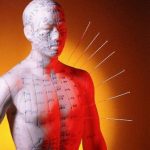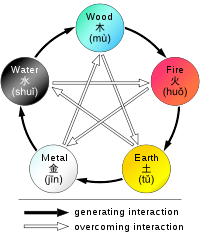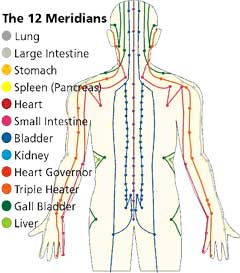Harnessing your Inner Qi: Traditional Medicine Theory Posted by Stephen on Jan 28, 2012 in Culture, Uncategorized
 Now that we’ve introduced traditional forms of) Chinese medicine, it’s time to take a look at the theory behind these timeless practices. Traditional Chinese Medicine (中医) is based on Yinyangism (later absorbed by Daoism).From this follows the belief that all parts of the universe (including the human body) are interconnected by correspondence of “qi”, blood, bodily fluids, zang-fu, and meridians within the body. When all five are in harmony, the body is at balance between yin and yang, leaving the subject in good health. However, if these five are out of sync, according to Chinese medicine, the subject will become ill.
Now that we’ve introduced traditional forms of) Chinese medicine, it’s time to take a look at the theory behind these timeless practices. Traditional Chinese Medicine (中医) is based on Yinyangism (later absorbed by Daoism).From this follows the belief that all parts of the universe (including the human body) are interconnected by correspondence of “qi”, blood, bodily fluids, zang-fu, and meridians within the body. When all five are in harmony, the body is at balance between yin and yang, leaving the subject in good health. However, if these five are out of sync, according to Chinese medicine, the subject will become ill.
Here’s how the five are related and interact:
Qi (气)
Traditional Chinese medicine covers a number of different kinds of practices, most of which focus on balancing the distribution or movement of the body’s qi (气)–a putative energy that has no real correlate in western medicine according to Daoist philosophical and religious conceptions of yinyang. In general, traditional Chinese medical theory holds that there is a finite amount of qi available in the body, sometimes distinguishing between natal (inborn/innate) qi and developed (harnessed/gained).
Qi is believed to be partially generated from food and drink, and partially from air (by breathing). Another considerable part of it is inherited from the parents and will be consumed in the course of life. Chinese traditional medicine distinguishes not only one but several different kinds of qi (气).Qi is defined by five “cardinal functions”:
1) Actuation (推动, tuīdòng) – of all physical processes in the body, especially the circulation of all body fluids such as blood in their vessels.
2) Warming (温煦, wēnxù) – the body, especially the limbs.
3) Defense (防御, fángyù) – against Exogenous Pathogenic Factors
4) Containment (固摄, gùshè) – of body fluids, i.e. keeping blood, sweat, urine, semen etc. from leakage or excessive emission.
5) Transformation (气化, qìhuà) – of food, drink, and breath into qi and blood.
Blood (血):
In contrast to qi, blood, or 血 (xuě) is a tangible aspect of Chinese medicine. It is, nevertheless, defined by its functions: nourishing all parts and tissues of the body, safeguarding an adequate degree of moisture, and sustaining and soothing both consciousness and sleep. Typical symptoms attributed to a dysfunction of xuě (such as a lack of it) are pale complexion, dry skin and hair, dry stools, numbness of hands and feet, forgetfulness, insomnia, excessive dreaming, and anxiety
Body Fluids (津液):
Closely related to blood are blody fluids or 津液 (jīnyė). Just like blood, body fluids are considered to be yin in nature, and defined first and foremost by the functions of nurturing and moisturizing the different structures of the body. Their other functions are to harmonize yin and yang, and to help with secretion of waste products. Body fluids are ultimately extracted from food and drink, and constitute the raw material for the production of blood; conversely, blood can also be transformed into body fluids.Their phsycial manifestations are: tears, sputum, saliva, gastric juice, joint fluid, sweat, urine, etc…
Zàng-fǔ (脏腑):
Zàng-fǔ or 脏腑 constitutes the centre piece of Chinese traditional medicine’s systematization of bodily functions. Bearing the names of organs, they are, however, only tied to rudimentary anatomical assumptions (the fǔ a little more, the zàng much less). Because zang fu is primarily defined by functions, zang fu organs are not equivalent to the anatomical organs.
The term zàng (脏) refers to the five entities considered to be yin in nature – Heart, Liver, Spleen, Lung, Kidney , while fǔ (腑) refers to the six yang organs – Small Intestine, Large Intestine, Gallbladder, Urinary Bladder, Stomach and Sānjiaō. The zàng’s essential functions consist in production and storage of qì and blood; in a wider sense they are stipulated to regulate digestion, breathing, water metabolism, the musculoskeletal system, the skin, the sense organs, aging, emotional processes, mental activity etc…The fǔ organs’ main purpose is merely to transmit and digest substances like waste, food, etc…
Since their concept was developed on the basis of Wǔ Xíng philosophy, each zàng is paired with a fǔ, and each zàng-fǔ pair is assigned to one of five elemental qualities (i.e., the Five Elements or Five Phases).These correspondences are stipulated as:
- Fire (火) = Heart (心) and Small Intestine (小肠) (and, secondarily, Sānjiaō [三焦, ‘’Triple Burner‘’] and Pericardium [心包])
- Earth (土) = Spleen (脾) and Stomach (胃)
- Metal (金) = Lung (肺) and Large Intestine (大肠)
- Water (水) = Kidney (肾) and Bladder (膀胱)
- Wood (木) = Liver (肝) and Gallbladder (胆)
The zàng-fǔ are also connected to the twelve standard meridians – each yang meridian is attached to a fǔ organ and five of the yin meridians are attached to a zàng. As there are only five zàng but six yin meridians, the sixth is assigned to the Pericardium, a peculiar entity almost similar to the Heart.
Meridians (经络):
The meridians or 经络 (jīng-luò) are believed to be channels running from the zàng-fǔ in the interior of the body to the limbs and joints. Chinese medicine identifies twelve “regular” and eight “extraordinary” meridians–the Chinese terms for which being 十二经脉 (pinyin: shí-èr jīngmài, lit. “the Twelve Vessels”) and 奇经八脉 (pinyin: qí jīng bā mài) respectively.

Build vocabulary, practice pronunciation, and more with Transparent Language Online. Available anytime, anywhere, on any device.
About the Author: Stephen
Writer and blogger for all things China related. Follow me on twitter: @seeitbelieveit -- My Background: Fluent Mandarin speaker with 3+ years working, living, studying and teaching throughout the mainland. Student of Kung Fu and avid photographer and documentarian.






Comments:
win astro:
just want to say this:thank you,I appreciate your medical information very much.